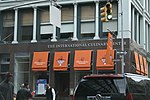A. J. Dittenhofer Warehouse
1870 establishments in New York (state)Broadway (Manhattan)Cast-iron architecture in New York CityCommercial buildings completed in 1870Commercial buildings in Manhattan ... and 5 more
Manhattan building and structure stubsResidential buildings in ManhattanSoHo, ManhattanUse mdy dates from November 2021Warehouses in the United States

The A. J. Dittenhofer Warehouse is a five-story cast-iron building at 427-429 Broadway in SoHo, Manhattan, New York City. Designed by Thomas R. Jackson in 1870, the building was converted to residential lofts in 2000 by the architect Joseph Pell Lombardi.
Excerpt from the Wikipedia article A. J. Dittenhofer Warehouse (License: CC BY-SA 3.0, Authors, Images).A. J. Dittenhofer Warehouse
Howard Street, New York Manhattan
Geographical coordinates (GPS) Address Nearby Places Show on map
Geographical coordinates (GPS)
| Latitude | Longitude |
|---|---|
| N 40.719988 ° | E -74.001736 ° |
Address
Howard Street 45
10013 New York, Manhattan
New York, United States
Open on Google Maps




